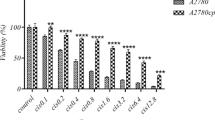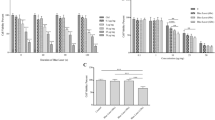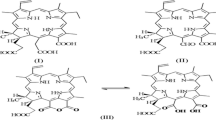Abstract
Objective
To compare the differences between 5-aminolevulinic acid photodynamic therapy (5-ALA-PDT) with traditional after-loading radiotherapy in aspects of efficacies and side effects.
Materials and methods
MTT assay was adopted to detect the inhibitive effects of 5-ALA-PDT on Hela cells proliferation. Flow cytometry was used to analyze cell apoptosis. After establishment of human cervical cancer xenograft model, the comparisons between 5-ALA-PDT with radiotherapy were performed with respect to treatment efficacies (survival rate, body weight, and tumor volume) and side effects (appearance and behavior, ovarian endocrine functions, and skin lesion around the tumor).
Results
5-Aminolevulinic acid photodynamic therapy exerted killing effects on cervical cancer cells. Morphological changes and flow cytometric analyses indicated apoptosis to be one of the mechanisms for tumor growth suppression. Both proliferation inhibition and cell apoptosis showed dependency on photosensitizer concentration and irradiation intensity. Repeated photodynamic therapy presented stronger inhibitive effects on tumor growth compared to after-loading radiotherapy, while producing milder impairment of ovarian endocrine functions and skin lesions around the tumors.
Conclusions
5-Aminolevulinic acid photodynamic therapy has great potential to be an alternative treatment modality for cervical cancer.






Similar content being viewed by others
References
Torres LA, Rojo HG, Torres RA, Hurtado Estrada G, Roman Bassaure E (2004) Cervical cancer: current view of its epidemiology and risk factors. Ginecol Obstet Mex 72:466–474
Wells SF (2008) Cervical cancer: an overview with suggested practice and policy goals. Medsurg Nurs 17(1):43–50
Macchia G, Ferrandina G, Deodato F, Bibbo R, Massaccesi M, Ippolito E et al (2011) 3D conformal postoperative radiotherapy with concomitant boost in uterine cancer: results of a phase I–II study (ADA-RT-1). Gynecol Oncol 120(3):485–488
Robova H, Halaska M, Pluta M, Skapa P, Strnad P, Lisy J et al (2010) The role of neoadjuvant chemotherapy and surgery in cervical cancer. Int J Gynecol Cancer 20(11 Suppl 2):S42–S46
Juarranz A, Jaén P, Sanz-Rodríguez F, Cuevas J, Gonzalez S (2008) Photodynamic therapy of cancer. Basic principles and applications. Clin Transl Oncol 10(3):148–154
Perotti C, Casas A, Fukuda H, Sacca P, Batlle A (2003) Topical application of ALA and ALA hexyl ester on a subcutaneous murine mammary adenocarcinoma: tissue distribution. Br J Cancer 88(3):432–437
Tunstall RG, Barnett AA, Schofield J, Griffiths J, Vernon DI, Brown SB et al (2002) Porphyrin accumulation induced by 5-aminolevilunic acid esters in tumor cells growing in vitro and in vivo. Br J Cancer 87(2):246–250
Zhu TC, Finlay JC (2008) The role of photodynamic therapy (PDT) physics. Med Phys 35(7):3127–3136
Lehmann P (2007) Methyl aminolaevulinate–photodynamic therapy: a review of clinical trials in the treatment of actinic keratoses and nonmelanoma skin cancer. Br J Dermatol 156(5):793–801
Dougherty TJ, Kaufman JE, Goldfarb A, Weishaupt KR, Boyle D, Mittleman A (1978) Photoradiation therapy for the treatment of malignant tumors. Cancer Res 38(8):2628–2635
He GF, Bian ML, Zhao YW, Xiang Q, Li HY, Xiao C (2009) A study on the mechanism of 5-aminolevulinic acid photodynamic therapy in vitro and in vivo in cervical cancer. Oncol Rep 21(4):861–868
Kim WC, Kim GE, Suh CO, Loh JJ (2001) High versus low dose rate intracavitary irradiation for adenocarcinoma of the uterine cervix. Jpn J Clin Oncol 31(9):432–437
Shakespeare TP, Lim KH, Lee KM, Back MF, Mukherjee R, Lu JD, American Brachytherapy Society (2006) Phase II study of the American Brachytherapy Society guidelines for the use of high-dose rate brachytherapy in the treatment of cervical carcinoma: is 45–50.4 Gy radiochemotherapy plus 31.8 Gy in six fractions high-dose rate brachytherapy tolerable? Int J Gynecol Cancer 16(1):277–282
Kwon OC, Yoon HJ, Kim KH, Kim HT, Yoon YH, Kim JK (2008) Fluorescence kinetics of protoporphyrin-IX induced from 5-ALA compounds in rabbit postballoon injury model for ALA-photoangioplasty. Photochem Photobiol 84(5):1209–1214
af Klinteberg C, af Klinteberg C, Enejder AM, Wang I, Andersson-Engels S, Svanberg S, Svanberg K (1999) Kinetic fluorescence studies of 5-aminolaevulinic acid-induced protoporphyrin IX accumulation in basal cell carcinomas. J Photochem Photobiol B 49(2–3):120–128
Heil P, Stocker S, Sroka R, Baumgartner R (1997) In vivo fluorescence kinetics of porphyrins following intravesical instillation of 5-aminolaevulinic acid in normal and tumor-bearing rat bladders. J Photochem Photobiol B 38(2–3):158–163
Juzenas P, Sharfaei S, Moan J, Bissonnette R (2002) Protoporphyrin IX fluorescence kinetics in UV-induced tumors and normal skin of hairless mice after topical application of 5-aminolevulinic acid methyl ester. J Photochem Photobiol B 67(1):11–17
Johansen P, Berg K, Selbo PK, Hofbauer GF (2010) Photochemical internalization (PCI): a further development of photodynamic therapy for the treatment of skin cancer. Praxis (Bern 1994) 99(23):1423–1428
Swartling J, Axelsson J, Ahlgren G, Kalkner KM, Nilsson S, Svanberg S et al (2010) System for interstitial photodynamic therapy with online dosimetry: first clinical experiences of prostate cancer. J Biomed Opt 15(5):058003
Johansson A, Palte G, Schnell O, Tonn JC, Herms J, Stepp H (2010) 5-Aminolevulinic acid-induced protoporphyrin IX levels in tissue of human malignant brain tumors. Photochem Photobiol 86(6):1373–1378
Gross SA, Wolfsen HC (2010) The role of photodynamic therapy in the esophagus. Gastrointest Endosc Clin N Am 20:35–53
Grant WE, Speight PM, Hopper C, Bown SG (1997) Photodynamic therapy: an effective, but non-selective treatment for superficial cancers of the oral cavity. Int J Cancer 71(6):937–942
Friedberg JS, Mick R, Stevenson JP, Zhu T, Busch TM, Shin D et al (2004) Phase II trial of pleural photodynamic therapy and surgery for patients with non-small-cell lung cancer with pleural spread. J Clin Oncol 22(11):2192–2201
Chiaviello A, Paciello I, Postiglione I, Crescenzi E, Palumbo G (2010) Combination of photodynamic therapy with aspirin in human-derived lung adenocarcinoma cells affects proteasome activity and induces apoptosis. Cell Prolif 43(5):480–493
Zhao B, He YY (2010) Recent advances in the prevention and treatment of skin cancer using photodynamic therapy. Expert Rev Anticancer Ther 10(11):1797–1809
Mackenzie GD, Dunn JM, Selvasekar CR, Mosse CA, Thorpe SM, Novelli MR et al (2009) Optimal conditions for successful ablation of high-grade dysplasia in Barrett’s oesophagus using aminolevulinic acid photodynamic therapy. Lasers Med Sci 24(5):729–734
Acknowledgments
This work was supported by the National Science and Technology Pillar Program during the Eleventh Five-year Plan Period of China (No. 2008BAI57B01, No. 2008BAI57B02).
Conflict of interest
None.
Author information
Authors and Affiliations
Corresponding author
Additional information
T. Gui and Y. Wang contributed equally to the work.
Rights and permissions
About this article
Cite this article
Gui, T., Wang, Y., Mao, Y. et al. Comparisons of 5-aminolevulinic acid photodynamic therapy and after-loading radiotherapy in vivo in cervical cancer. Clin Transl Oncol 15, 434–442 (2013). https://doi.org/10.1007/s12094-012-0945-5
Received:
Accepted:
Published:
Issue Date:
DOI: https://doi.org/10.1007/s12094-012-0945-5




